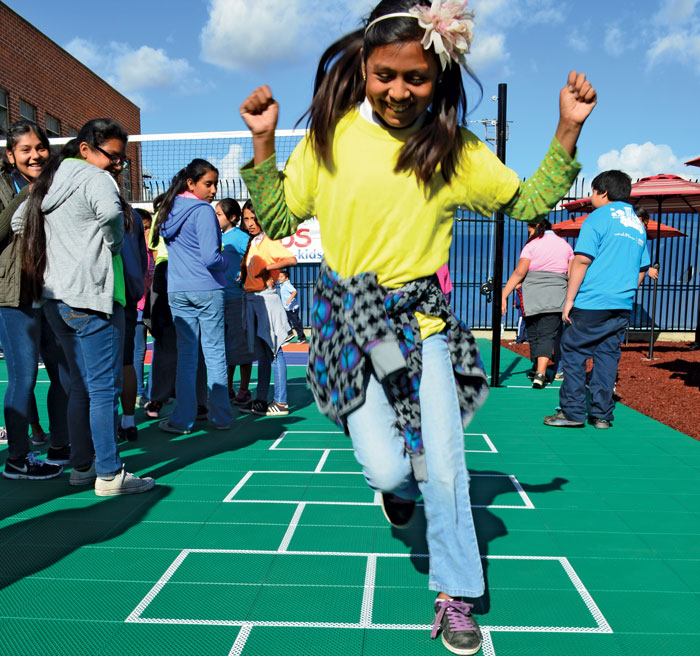According to the Sports & Fitness Industry Association, pickleball continued its meteoric rise in 2022, remaining America’s fastest growing sport. Participation nearly doubled, increasing 85.7% year-over-year and by “an astonishing 158.6%” over three years. Parks and recreation leaders as well as sports facility directors have been leaping on this trend, looking for ways to ensure they can accommodate the growing demand for places to play. And the good news is that it’s relatively simple to make room for pickleball amongst your other court sport offerings.
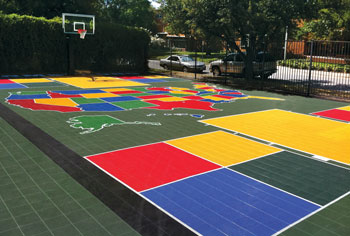
“Outdoor courts are a huge draw for all parks,” said Marty Greenwell, vice president of sales and marketing for a Louisville, Ky.-based manufacturer of coatings for court surfaces (including pickleball), swimming pools, pool decks and other surfaces. “Tennis and basketball are traditional draws. Pickleball is the relatively new kid on the block and attracting thousands of participants.”
“There is no question that pickleball is on the rise,” said Stephanie Corrigan, director of brand and product marketing for a Salt Lake City, Utah-based provider of sport courts. “We hear from parks and recreation departments and HOA communities regularly saying they have a demand from their community members to add pickleball courts. We advise these communities to consider renovating the underused areas and transforming them into pickleball courts with a safe surface to allow their community members to play for hours at a time with [a] surface engineered specifically for pickleball.”
According to Jake Angrisano, sales representative for a manufacturer of court flooring, tennis court resurfacing and other surface solutions based in Utica, N.Y., communities have taken a variety of paths to address the rising popularity of pickleball, “from both the construction and designation of brand-new pickleball courts, to repurposing preexisting courts that either do not service what the community is interested in or are dilapidated and in need of some care.
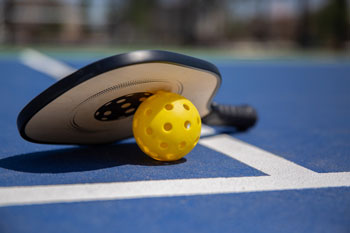
“As pickleball specifically continues to grow, we are seeing communities that are converting old tennis or basketball courts into a number of new pickleball court spaces,” he added. “This is especially efficient as a standard-sized tennis court can be converted into four 60-foot-by-30-foot pickleball court spaces, allowing for more players to utilize the same space at the same time. When planning for these conversions or new constructions, it is especially important to ensure that your surface is able to accommodate multiple sports and activities if needed to allow for the maximum amount of use possible.”
“Taken together, outdoor courts are a definite customer draw,” Greenwell added. “Maintaining these courts and/or converting existing space to multi-use are two critical components of the overall park management plan.”
Make Space for Pickleball Courts
According to USA Pickleball, it’s a fun sport combining elements of tennis, badminton and ping-pong. It can be played either indoors or outdoors on a badminton-sized court with a slightly modified tennis net. Equipment is simple: Players use paddles and a plastic ball with holes. It can be played as doubles or singles, and offers enjoyment to players of all ages and skill levels.
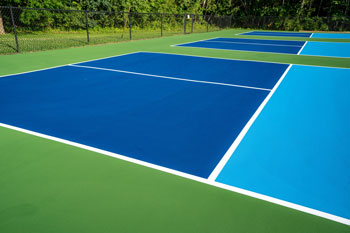
USA Pickleball’s website states that a pickleball court is the same size as a doubles badminton court, and measures 20 by 44 feet. The same court is used for both singles and doubles play. The net height is 36 inches at the sidelines and 34 inches in the middle, and the court is striped similarly to a tennis court, with right and left service courts and a 7-foot non-volley zone in front of the net that’s called the “kitchen.”
With these basics down, you can turn to deciding how to accommodate the sport in your facilities. We asked our experts to weigh in on what you should consider when adding pickleball courts to your facility.
“There are several factors to consider when designing and installing pickleball courts specifically, and all outdoor courts in general,” Greenwell said. “These include space constraints, the end use of the courts to be installed (also single use vs. multi-use), expected level of use, court orientation, court surface material and color schemes, to name a few. And, of course, available budget dollars always play into the decision-making process.
“In many cases,” Greenwell added, “it is existing courts being converted to multi-use—adding pickleball lines to an existing tennis court is a great example and one that is often used—especially considering budgetary and space constraints and the exploding popularity of pickleball across the country.”
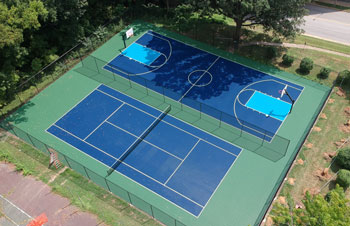
Orientation is also a factor in your planning process, as “… the preference is typically to have outdoor courts run north-south in their layout,” Greenwell said. “This helps reduce shadows and minimize participants looking directly into the sun.”
Think about how to optimize your space, the durability of the surface you choose and the safety the surface provides to community members, Corrigan suggested. Her company’s pickleball-specific surface “… provides excellent playability and incorporates shock absorption for the safety of the athletes, something traditional hard-court surfaces do not have.”
Angrisano added that factors and feedback his company has heard from park directors include the courts’ location “… in relation to local residents, as well as the number of pickleball courts that can fit within their designated space, and, just as importantly, the process of deciding on the type of surface that will fit their user base’s expectations and budget over the lifespan of the courts.”
Maintenance needs over the lifespan of the courts is also an important consideration, Greenwell said. “Outdoor courts are often constructed of asphalt or concrete and can be easily maintained with court coatings on the market today,” he said. “Court coatings are a very effective avenue to keeping all courts looking new and providing excellent playing surfaces for all types of courts. Court coatings also offer a convenient, low-cost approach to converting existing courts to multi-use as multiple colors are available to provide the needed differentiation.”
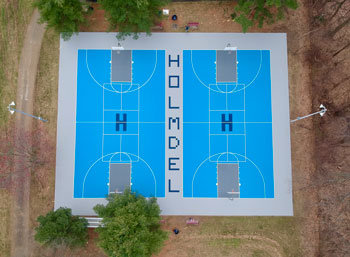
Considering the sport’s popularity, people will be clamoring for your available courts, which means it’s also important to figure out how to offer as many opportunities for play as you can fit into the space you have available.
“In regard to fitting the maximum amount of courts into a designated footprint, we have seen a number of customers convert existing single tennis courts into multiple pickleball courts by rearranging their court layouts, and this ultimately allows for more courts and more players within the same footprint of space,” Angrisano explained.
“The type of surface that is selected for these courts is also very important,” he added. “Modular tile is an excellent choice for those looking for a durable, low-maintenance option with the ability to be used for multiple applications.”
Be aware that modular sport tiles “… do require a flat, solid subsurface to lay over, such as asphalt or concrete,” Angrisano said, “and this makes it an excellent candidate for those looking to revitalize an existing court that is in need of some additional care.”
But Don’t Forget Other Favorites!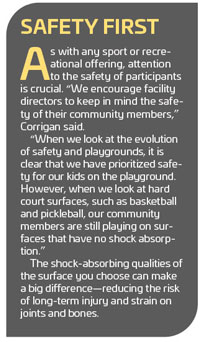
While pickleball is hugely popular today, that doesn’t mean your visitors have forgotten other perennially favorite sports that require hard surfaces, like tennis and basketball. To accommodate everyone, now and into the future, consider ways to make your courts usable for multiple sports.
“Pickleball is extremely popular, and new construction of courts is at a high level. However, as mentioned, constructing new courts may be space- or cost-prohibitive,” Greenwell said. “Multi-use of existing tennis courts is the answer—use varying colors to mark pickleball courts onto tennis courts.”
“Utilizing a single space for multiple applications allows for customers to get the greatest value out of their investment,” Angrisano agreed.
“As many as four pickleball courts can be placed onto a typical tennis court,” Greenwell explained. “Temporary nets may be used to allow easy conversion from tennis to pickleball. This allows facilities the flexibility to switch back and forth and schedule by sport as needed.”
Greenwell added that basketball is also still very popular, with basketball courts found in many parks. “Often these are separate courts and can be maintained just like the tennis courts and pickleball courts,” he said. “Many color schemes are available. In some cases, basketball courts are lined onto existing courts—mostly for the foul line and the three-point arc. This is where varying colors come into play to differentiate the various courts being incorporated into a multi-use surface.”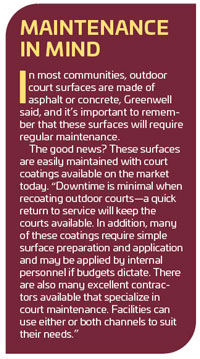
“A great way to make sure communities do not lose sight of other sports that people have loved for years and will continue to love for years is to consider a multisport surface and court design,” Corrigan added, adding that her company provides an outdoor surface that is “… ideal for pickleball and basketball, and we commonly install courts that have pickleball lines and basketball lines, as well as pickleball nets and basketball hoops.” The company’s builders can work with parks and other facility owners to design the court that will meet all of the local community’s demands for court sports.
“Some favorite court applications that we commonly service are pickleball, tennis, basketball, volleyball and inline hockey/roller skating,” Angrisano added. “Over the past several years we have seen a huge boom in pickleball specifically, and luckily this works very well with tennis court restoration projects as we can include pickleball game lines within a standard tennis court to either share a net or to create several pickleball courts within a single tennis court.
“While basketball remains a very popular application as well, we have also seen a rising interest in inline hockey and roller-skating projects, and we have been able to combine these applications by including multiple sets of game lines as needed,” he added, explaining that his company makes a variety of products with different attributes that can cater to the specific needs and demands of any given community. RM



